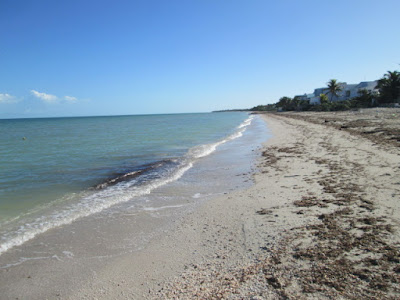The beach, of course, is the beach: mile after mile of constantly-changing sky- and seascapes.
On the other side of the houses, out of the wind, things look a little different,
and different again a few hundred yards away past the edge of the village.
A reminder that this part of the Yucatan is basically desert, with a few inches of soil over limestone. Those spiky-looking plants, by the way, are some variety of agave, though whether they are potentially tequila, I do not know.
Any plants that survive in this general area have to be salt-tolerant, as the norte winds sometimes coat furniture thirty feet from the high tide line with salt spray. Sea grape seems to cope fairly well, as does an attractive succulent-leaved shrub planted in front of many of the beach houses.
On the calle, people are growing a much greater variety--lots of bougainvillea, oleander, plumeria, ciricote (which not only sports these gorgeous orange flowers but produces edible fruit and a valued hardwood),
 |
| Cordia dodecandra |
and this lovely shrub that I have yet to identify.
These differing ecosystems host different animal life. Even though birds fly, the grackles and great kiskadees common on the calle rarely venture beachside,
 |
| A great kiskadee on a wire on Calle 17 |
while I have yet to see any shorebirds other than the gloriously floating frigates in the airspace beyond the pool terrace.
 |
Pair of Frigate magnificens, or magnificent frigatebird. The white-throated bird is the female.
|
(Update: 24 hours after the original posting, I spotted two pelicans flying away from the Gulf toward the lagoon.) The beach is home to some interesting characters. Gulls and pelicans are everywhere, and the tropical cormorant, here drying its non-waterproof feathers, is a common sight.
and frequently rests in groups atop buildings, posts, and other structures.
(I recommend against walking too closely to any such groups, as the cormorant's bowel movements can be explosive.)








1 comment:
Love the article. The end is a nice touch.
Post a Comment